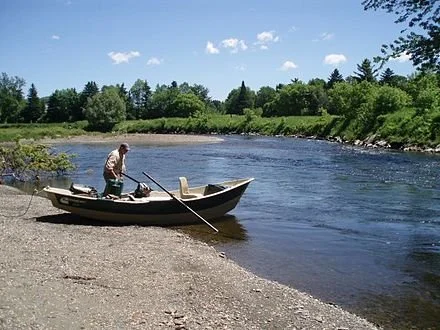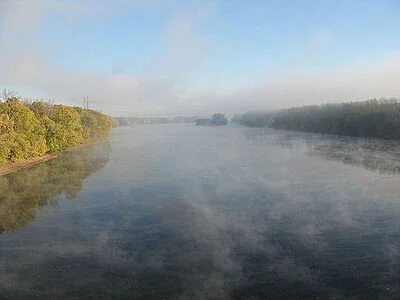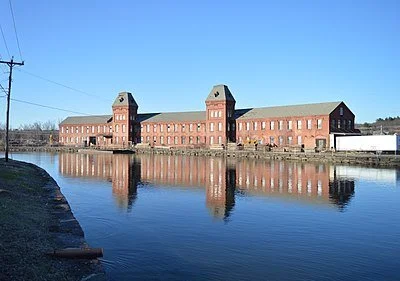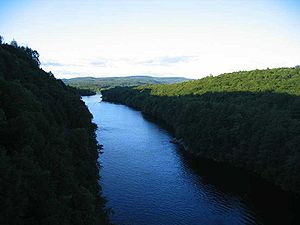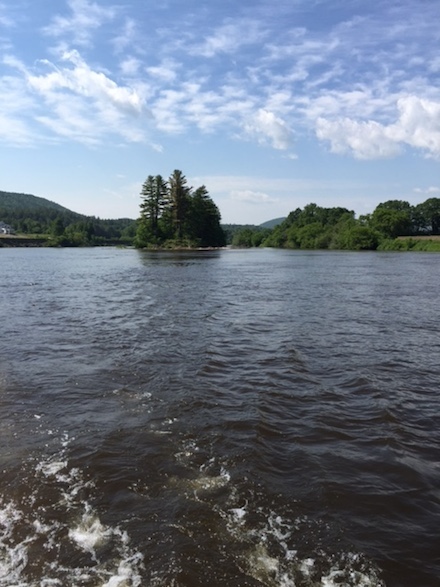
Where he wanted to be
The Connecticut River depositing silt as it enters Long Island Sound at Old Lyme
“I have seen rather more of the world’s surface than most men ever do, and I have chosen the valley of this river for my home.’’
—Roger Tory Peterson (1908-1996), in The Connecticut River, by Evan Hill (1972).
Peterson was a famed ornithologist and naturalist and author of best-selling wildlife guides. He lived in Old Lyme, Conn.
#Connecticut River
Riverine review
A visitor walks through work in the group show "One River, Many Views," at Saint-Gaudens National Historical Park, in Cornish, N.H., through Oct. 30.
— Photo Courtesy Saint-Gaudens National Historical Park
The park says:
“One River, Many Views’’ features the work of Nancy Diessner (Mass.), Brenda Garand (N.H.), and Janet Pritchard (Conn.), whose work responds to the Connecticut River’s beauty, its power and its history. These artists work in a variety of media, including photography, drawing, printmaking and sculptural forms, at times using the river water, its soil and its flora as part of their art-making process. In addition to the artwork, the show features commissioned wall labels written by 10 members of the Upper Valley community who live in, work in and otherwise engage with the Connecticut River. These include creative writers, scholars and simply residents, as well as those from the indigenous, agricultural, recreational and other communities for whom the river is an important part of their daily lives. Their responses – reflective, celebratory, or interrogatory — will highlight the diverse natural and cultural histories and relationships with this imposing body of water. The exhibition seeks to encourage discussion as well as awareness of the ways that one topic can hold multiple approaches, opinions, expertise, and experiences.’’
Drift boat fishing guide preparing to work the river near Colebrook, N.H.
Those boots are history
“Vern has gone up to the attic to hunt for a fish pole and I trailed along after him. The attic was just like that of any other North Country farmhouse – cobwebby corn, and old clothes; corners piled full of haircloth trunks, boxes, and dead furniture. I saw a homemade cradle, an ancient spinning wheel, a flax-carder, piles of books and magazines and then, suspended from a nail, two pairs of rivermen’s boots….Vern took them in one huge hand and held them almost tenderly. ‘These boots, young feller,’ he said to me, ‘may be said to mark the passing of an era.’’’
From Spiked Boots: From New England’s North Country, True Stories of Yesteryear, When Men Were Rugged and Rivers Wild, by Robert Pike (1905-1997), a scholar and writer who grew up in Waterford, Vt., on the Connecticut River.
Looking across the Moore Reservoir at Waterford, Vt.
'A local abstraction;'
Mist upstream of the Bissell Bridge, between Windsor and South Windsor, Conn
”It is the third commonness with light and air,
A curriculum, a vigor, a local abstraction . . .
Call it, one more, a river, an unnamed flowing….’’
— From “The River of Rivers in Connecticut,’’ by Wallace Stevens (18790-1955). It’s “about” the Connecticut River. Like many in the Nutmeg State in his lifetime, he was an insurance executive.
“View of the City of Hartford, Connecticut,’’ by William Havell, a 19th Century painter
Rural independence
Mist upstream of the Bissell Bridge, over the Connecticut River between Windsor and South Windsor, Conn.
“Inhabitants of this {Connecticut River} valley ... are so remote from a market as to be perfectly free from that sense of inferiority customarily felt by the body of people who live in the neighborhood of large cities. Hence a superior spirit of personal independence is generated and cherished.’’
— Timothy Dwight (1752-1817), in Travels in New England and New York. Born in Northampton, Mass., he was president of Yale in 1795-1817 as well as a noted author and theologian.
View of the Connecticut River’s Oxbow, in Northampton, Mass., by Thomas Cole (1836)
'Millions of dark, sooty bricks'
The Albion Paper Mill, designed by internationally renowned mill architect David H. Tower, c. 1869, an example of Second Empire industrial architecture in Holyoke.
High Street in downtown Holyoke, circa 1920
“Holyoke {Mass.} is pure New England mill town….First there is the {Connecticut} river, wide and full of rapids, swinging around a curve, and then the city itself, climbing the hills on the far bank. Holyoke is vast, dense, and somber….Smokestacks and church spires reach into the sky. There are bricks, millions and millions of dark, sooty bricks, and a wealth of detail: granite windowsills, brass weathervanes, copper-sheathed cupolas, bell towers, ornamental ironwork, heavy wooden doors, cobblestone alleys, stone steps worn smooth by millworkers’ feet.’’
— Ben Bachman in Upstream: A Voyage on the Connecticut River (1985)
Rejoice in the river
Mist upstream of the Bissell Bridge over the Connecticut between Windsor and South Windsor, Conn.
"{If} the river is as varied and beautiful as the Connecticut, you can merely look at -- in the long light of a sultry summer evening, under an angry winter sky, in the high color of autumn or the pastel shades of spring -- and derive that sense of peace and uplift of the spirit that most men find in living water.''
-- The late Roger Tory Peterson, Connecticut-based naturalist, ornithologist, artist and educator, whose work is considered one of the founding inspirations for the 20th-Century environmental movement.
This quote is from The Connecticut River, by Evan Hill (1972)
Knowing when it's enough
The Connecticut River, looking north from the French King Bridge at the Erving-Gill (Mass.) town line.
The Oxbow of the Connecticut River in Northampton, Mass., circa 1910.
"A farmer … has an enormous innate need to simply hold still, to keep what he’s got, to limit greed to what he can keep….What’s the use of owning more than you can plough, or hay, or cut into sawlogs or pulp or firewood in the wintertime, or drive spikes into to bleed out maple sap in sugar time? No use, at all. In the Connecticut Valley, this trait has saved a lot of beauty.''
-- Evan Hill, in The Connecticut River (1972)
3-year floodplain-restoration project to start soon along the Connecticut River in Mass.
"View of Springfield {just south of Springfield}, on the Connecticut River,'' by Alvan Fisher.
Via ecoRI News (ecori.org)
LONGMEADOW, Mass.
Large-scale restoration of natural floodplain features and native plants will begin soon on land along the Connecticut River, including 223 acres recently transferred to The Nature Conservancy (TNC) by the trustees of the former Fannie Stebbins Memorial Wildlife Refuge.
Easily visible from Interstate 91 in the suburbs of Springfield, the land is part of one of the most sizeable natural and largely protected floodplain areas in the Connecticut River watershed. In addition to the land-based restoration efforts, work also will take place on part of the adjoining Silvio O. Conte National Fish & Wildlife Refuge and town of Longmeadow lands.
Floodplains are natural water‐storage areas for snowmelt, spring rains and, increasingly, severe storms that cause the Connecticut River and its tributaries to overflow. These areas also act as natural filters, trapping sediment, nutrients and pollutants before they reach rivers and coastal seas, thereby improving water quality.
“Floodplains once covered wide stretches along the Connecticut River and its tributaries, but today, they’re only a fraction of this important ecosystem,” said Kim Lutz, director of TNC’s Connecticut River Program. “The Fannie Stebbins land presents a remarkable opportunity to protect and restore a portion of that habitat.”
TNC and U.S. Fish & Wildlife Service are leading the three-year restoration project, which will include reduction of forest fragmentation by returning seven old fields to floodplain forest; control of invasive plants; and restoration of natural hydrological features.
Work on the 223-acre TNC section is being completed with funding from the Agricultural Conservation Easement Program administered by the U.S. Department of Agriculture’s Natural Resources Conservation Service (NRCS).
This spring, the NRCS purchased a permanent wetlands reserve easement on this section — the first such easement in Massachusetts on the mainstem of the Connecticut River.
“The benefits of restoring, enhancing and protecting critical wetlands cannot be overstated,” said Christine Clarke, Massachusetts State Conservationist for NRCS.
After the easement purchase, fee ownership of the land, plus another 21 acres, was donated to TNC.
This land was previously part of the Fannie Stebbins Memorial Wildlife Refuge owned and managed by a board of trustees elected by the Allen Bird Club, whose members had the foresight to acquire the land in multiple, separate parcels beginning more than 60 years ago.
The refuge was named for Fannie Stebbins, a nationally recognized biologist and educator who was head of Science and Nature Studies in the Springfield School System in the 1930s and ’40s. In 1972, the National Park Service designated the Stebbins Refuge a National Environmental Education Landmark. Massachusetts Audubon has recognized it as an “Important Bird Area,” as hospitable lodging for migrating birds.
In keeping with the Stebbins trustees’ wishes, the land is planned to eventually become part of the Conte Refuge, after the three-year restoration project.
During the three-year restoration project, activities will include mowing, herbiciding and plowing the fields to prepare for tree planting; targeted use of herbicide in forested areas to control invasive plants; and the use of heavy equipment to remove a berm. Temporary closures over portions of the area will occur for public safety when work is underway.
Of climate change and N.E. floods
-- Photo by UMass Amherst
This photo shows how the Connecticut River spewed sediment into Long Island Sound on Sept. 2, 2011, showing the widespread erosion caused by Tropical Storm Irene.
Via ecoRI News (ecori.org)
AMHERST, Mass.
Lake sediments reveal that erosion from Tropical Storm Irene flooding in 2011 caused the most severe erosion of the historic record, according to a new study.
The recent study reveals that increasing soil moisture is raising flooding, erosion and landslide risks in New England, and found that erosion risks have multiplied four times as a result of climate change.
Led by University of Massachusetts Amherst geologist Brian Yellen, a team of scientists has been using sediment deposits in New England lakes to evaluate erosive destruction of historic floods. When floodwaters reach the quiet conditions of a lake, they drop their sediment and leave a layer at the lake bottom that can be used to reconstruct the erosive conditions of the causal flood, according to the researchers.
In a new paper in the journal Earth Surface Processes and Landforms, Yellen and his team show that the 2011 flood from Tropical Storm Irene in Massachusetts and Vermont caused historically unprecedented erosion in the form of landslides and rivers that jumped banks and destroyed most everything in their paths.
“When considering river floods here in hilly New England, the greatest risk we face is from fast, steep rivers undermining our structures — not from broad areas of inundation, like in the flat Midwest,” Yellen said.
Using chemical clues in the sediment layers, Yellen and his team showed that Irene flooding was uniquely capable of eroding ancient glacial till, riverbank material that has remained unmoved for the past 15-20 thousand years. Previous storms with greater precipitation totals and peak river flows weren’t as erosive, according to Yellen.
So what made Irene so erosive and destructive? It turns out that the 2011 tropical storm arrived on the tail of an anomalously wet period. In Vermont, total precipitation for the month immediately before Irene fell in the 95th percentile.
Increased soil moisture weakened banks and allowed for massive erosion, despite river flows that had been exceeded in the instrumental record.
Most alarming, the study found that rainfall statistics are shifting as a result of climate change. Based on trends in rainfall records, monthly preceding rainfall for Irene was four times more likely in 2011 than in 1911, according to the researchers.
“The jury is out on whether we will see more hurricanes as a result of climate change,” Yellen said. “But what is known with a good deal of confidence is that our region will continue to become wetter. This increasing baseline moisture primes the system for maximum destruction when big rain events occur.”
Crows' business model; river town
Crows, which are highly intelligent, if often associated with death, have a very effective business model as scavengers. Indeed, being a good scavenger of things and ideas seems essential for thelong-term success of most of us. (A successful investor is a particularly good scavenger -- an outstanding opportunist.)
"Two Crows,'' by JAMES REED, in his show at Gallery19, in Essex, Conn., through June 3o.
Crows, which are highly intelligent, if often associated with death, have a very effective business model as scavengers. Indeed, being a good scavenger of things and ideas seems essential for the long-term success of most of us. (A successful investor is a particularly good scavenger -- an outstanding opportunist.)
When I was a kid living on thepre-environmentalist coast, seagulls were protected because they cleaned up the garbage left in the open. They did a particularly fine job on the remnants of beach picnics. Crows do the same thing and swiftly consume roadkill, too.
Essex, by the way, is a beautiful town on the Connecticut River, one of several beautiful communities in its area. New England is not famous for its big rivers, of which the Connecticut is the only one, and doesn't have many of what you would call "river towns'' in, say, a Midwestern or Southern sense.
But the Connecticut looks pretty big in the southern Nutmeg State and Essex is definitely a river town, with all that implies about water-borne transportation, commerce and culture in general.
Celebrating water protection in N.E.
A stretch of the Connecticut River in western Massachusetts.
BOSTON
At a spot overlooking Boston Harbor, once choked with toxic pollution but now home to some of the cleanest urban beaches in the United States, advocates gathered July 1 to thank the Obama administration for closing loopholes in the Clean Water Act that previously left more than half of Massachusetts’s streams at risk of pollution.
“We’ve made so much progress in cleaning up our waterways, and we can’t afford to turn back the clock,” said Ben Hellerstein, state director for Environment Massachusetts. “The EPA’s Clean Water Rule will make a big difference in protecting Boston Harbor, the Charles River and all of the waterways we love.”
The Clean Water Rule, finalized in late May, clarifies federal protections for waterways following confusion over jurisdiction created by Supreme Court decisions in 2001 and 2006. It restores Clean Water Act protections to thousands of miles of streams that feed into waterways that provide drinking water for millions.
“In New England, protecting our water is more important than ever, especially as we work to adapt to climate-change impacts such as sea-level rise and stronger storms,” Environmental Protection Agency (EPA) Regional Administrator Curt Spalding said. “Protecting the most vulnerable streams and wetlands — a drinking-water resource for one in three Americans — helps our communities, and this rule provides clarity for businesses and industry without creating new permitting requirements.”
Before the Clean Water Rule became law, small streams, headwaters and certain wetlands were in a perilous legal limbo, allowing polluters and developers to dump into them or destroy them in many cases without a permit. In a four-year period following the rule’s creation, the EPA had to drop more than 1,500 cases against polluters, according to one analysis by The New York Times.
Prior to the passage of the Clean Water Act in 1972, Massachusetts waterways suffered from decades of pollution and neglect. As late as the 1980s, untreated sewage was regularly dumped into Boston Harbor, and high concentrations of industrial pollutants posed a public-health risk.
The Clean Water Act prompted a major cleanup of the harbor. Today, Boston boasts some of the cleanest urban beaches in the nation, and wildlife habitat has significantly improved, according to Environment Massachusetts.
Advocates pointed out that the Clean Water Act has enabled similar improvements in water quality in many of the state’s most iconic waterways, from the Charles River to the Connecticut River.
Despite broad public support for clean-water protections, polluting industries and some members of Congress are fighting to block implementation of the Clean Water Rule. In recent weeks, congressional committees have approved multiple bills aimed at rolling back the Clean Water Rule.
Robert Whitcomb: Health-care beacons, Snowden, our big river
The Connecticut River at Orford, N.H. (See item at bottom.)
Much of American health care’s future can be seen in two synergistic kinds of institutions in Rhode Island.
One is Federally Qualified Health Centers (FQHCs). These facilities, set up around America, provide a wide range of free and insurance-subsidized clinical help for millions of patients, most of them low-income. The other is Johnson & Wales University’s spanking new Center for Physician Assistant Studies.
Consider the state’s biggest FQHC organization -- Providence Community Health Centers (PCHC). Its teams of physicians and other clinicians, such as nurses and nurse practitioners, work for what is the biggest single provider of primary-care services in Providence, with more than 35,000 patients. (I toured PCHC’s immaculate Prairie Avenue campus the other week, led by Merrill Thomas, its CEO, and Jane Hayward, the Rhode Island Health Center Association’s president.)
PCHC ‘s mission, it says, is to “provide neighborhood-based high quality and accessible primary medical care to improve the health status of the residents of Providence and surrounding communities regardless of their ability to pay.’’ FQHCs play especially important roles in inner cities and impoverished rural areas, such as Appalachia, where many physicians don’t want to practice, especially because of low reimbursement and so many difficult cases involving seemingly intractable behavioral-health issues.
Expanding primary care -- especially preventive care -- is essential if America is to improve overall health outcomes that are near the bottom of the Developed World while better controlling medical costs, which are the highest.
Whatever happens with the Affordable Care Act, the U.S. population’s aging (older means sicker); the daunting complexity of our health-insurance system; the permanent exit of many well-paying jobs; emigration to the United States of low-income people, and the decline of the stable, two-resident-parent family suggest that Federally Qualified Health Centers ought to play even bigger roles.
Of course, increasing the numbers of primary-care clinicians is essential for the long-term success of these clinics. Doing just that is the Johnson & Wales Center for Physician Assistant Studies, which has a beautiful building in Providence’s Jewelry District. George Bottomley, its director, gave me a tour the other week.
Its 24-month master’s program addresses the need to train many more non-physician clinicians who can perform highly professionally and cost-effectively some of the tasks now performed by over-worked (if highly paid) doctors. PAs are especially useful in getting patients to make the behavioral changes needed to prevent serious illness, in part because they can generally spend more time with patients than can physicians; many of the latter are more harried than ever because of onerous electronic-health-record duties and administrative pressures to boost patient volume.
J&W notes that PAs work in integrated medical teams to “provide diagnostic, therapeutic and preventive health-care services.’’ (By the way, the differences between physician assistants and nurse practitioners mostly involve some education details. They’re very similar professions.)
With physicians as supervisors, physician assistants take patients’ histories and perform exams; order lab tests; prescribe medications; diagnose illnesses; develop treatment plans, and counsel and educate patients.
No wonder that demand for PAs is surging. Forbes.com has listed Physician Assistant Studies as the “No. 1 Best Master’s Degree for Jobs.’’ The American Academy of Physician Assistants (AAPA.org) says that “demand for physician assistants and nurse practitioners rose by more than 300 percent in the last three years.’’
We’ll need Johnson & Wales PAs in droves in coming years as, technology, demographics and new cost controls continue to transform U.S. health care for all patients, especially in primary care, in which physician assistants will be at the forefront.
xxx
Edward Snowden – as a Russian spy and/or as an arrogant but naïve narcissist-- has provided vast amounts of U.S. security information to Vladimir Putin’s police state, perhaps resulting in the death of agents working for us. And he has aided the Chinese dictatorship’s relentless cyber-warfare against America. Some hero!
xxx
Last week we cruised the gorgeous Upper Connecticut River on a pontoon boat. Because it’s by far New England’s biggest river, on it you get a sense of what Mark Twain might have felt on the Mississippi. We yakked desultorily in the soft breeze about big projects we’d do – as if we were 30 years younger than we are.
Robert Whitcomb (rwhitcomb51@gmail.com), overseer of New England Diary, is a partner in Cambridge Management Group (cmg625.com), a healthcare-sector consultancy, and a fellow of the Pell Center for International Relations and Public Policy.




